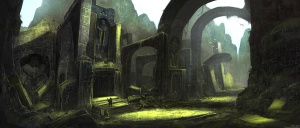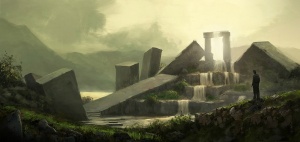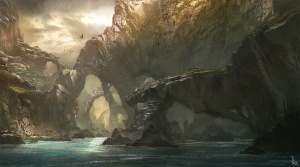
|
The Jedi were real? This article is part of the history of Clan Odan-Urr and isn't part of current events.
Please do not remove this tag or the contents. These articles exist for historic purposes.
|
History
Prehistory/Antiquity
 Temple created by the Lost Tribe of Harakoa
Temple created by the Lost Tribe of Harakoa
Tribesmen of the Harakoan species had first discovered the Bahari islands over four millennia before the arrival of the Jedi while exploring beyond the coasts of Kamuekiko. However, the chain of islands off the eastern coast of Kamuekiko became forgotten for several centuries, until its rediscovery two centuries later. At this time, scouts of an unknown Harakoan tribe developed a crude method of transportation with which to cross the Bythic ocean. These first explorers to set foot on the islands had discovered ruins of an ancient forgotten culture. However, recent studies into the Bahari islands have revealed that the first culture who settled on the islands were likely one of the first civilizations to populate Harakoa. There has been no evidence to suggest conflict that may have resulted in the abandonment or eradication of the ancient culture.
Referred to as the "Lost Tribe of Harakoa" before Jeryn Yorcot's founding of the Maia'toa, archeological studies into the ruins have uncovered several underground and sunken temples. Inscriptions recovered from the stone murals suggest that the first civilization of the Bahari islands were some of Harakoa's first architects. These builders were capable of feats beyond their time in Harakoan evolution, having constructed several temples above the island's surface. Over time, these structures have fallen into ruin, being pulled into the rainforest as nature began to reclaim the stone dwellings.
Second Civilization
 Ruins of the First Civilization
Ruins of the First Civilization
First Discovered by Harakoan scouts, Iwu Kisiwa Makazi began with the creation of a second civilization in the Bahari islands. Under the leadership of Harakoan mystics, Iwu Kisiwa Makazi was formed. One of the few tribes without a warrior culture present, Iwu Kisiwa Makazi is a tribe that only seeks to preserve the knowledge of the Lost Tribe of Harakoa. Distrustful of outsiders, Iwu Kisiwa Makazi is as secluded and remote as the islands they protect. Originally comprised of Harakoan mystics and hunters arriving to the chain of islands through the use of longboats, Iwu Kisiwa Makazi is one of the smallest Harakoan tribes. The mystics have studied the ruins and artifacts of their ancestors, leading them to believe in the preservation of the remnants of this culture.
After the initial repopulation of the Bahari islands, Iwu Kisiwa Makazi had closed themselves off from the outside world. Secluded from the other tribes, Iwu Kisiwa Makazi have evolved differently than the modern tribes. Becoming introverted, the inhabitants of the rainforest islands had begun restoring small portions of the ruins, studying the craftsmanship of their ancestors. As temples were unburied, so too did their secrets surface. Rumored among Jedi scholars to be the echoes of a culture with insight into the mystical energies now called the "Force," this interest in the Bahari's secrets has been responded to with a distrustful watchfulness from the mystics of the Iwu Kisiwa Makazi. Fearing an invasion from relic hunters or knowledge-seekers, the Iwu Kisiwa Makazi has trained a small force of Mwangalizi, commonly known as the "Wardens of Kisiwa Makazi," to stand guard over the ruins. Expanding the unearthed ruins and outlying rainforest to include traps, their efforts have deterred Cy Thuron's monarchy from taking significant interest in the invasion of these islands.
Territory
The territory of the second civilization of the Bahari islands off the eastern coast of Kamuekiko are the largest islands in the region. However, the entire chain of islands only stretches 1,000 kilometers from north to south. With a landmass of roughly 6,000 square kilometers, the Bahari islands are populated by a rough estimate of 2,000 Harakoans. Only populating the three largest islands, the Harakoans are divided with the vast majority populating the largest and most central island, Fahari Island. Comprised of an entire chain of islands, the Bahari islands are known to be the largest islands off the coast of the continent. Translated roughly as the "Ocean Islands," the Bahari islands were never fully explored, and only a handful of its ancient temples were ever located.
Geography
Fahari Urefu
 Fahari Island
Fahari Island
The central and largest island is home to over one thousand Harakoans, intent on preserving the secrets of their ancestors. Covered in tropical rainforest, Harakoans are wise to not travel alone. While mostly covered in a dense canopy, small clearings exist where the largest temples were built. These clearings are few, as most of them have been reclaimed by nature. If one were to venture underground, they would find a network of the temples that once stretched towards the stars. Interconnected, this network of temples is often falsely assumed to be one massive structure. While most of the entrances were lost to time, a handful of them were recovered in recent decades, which is theorized to be a reason behind the sudden disappearance of the Lost Tribe of Harakoa. Largely inaccessible, this central island is located several feet above ocean level. Known only the Harakoans who dwell here, a secret passage exists in one of the island's many cliff faces, accessible by longboat that will take one through a recovered portion of the underground network and eventually to the island's rainforest. Translated into basic as the "Pride Heights," the Harakoans have been careful of outsiders. Despite many attempts at negotiation, the Kisiwa Makazi tribe has only ever allowed a handful of researchers to enter the island.
Kisiwa Ya-Mwangwi
The second, and northernmost of the three islands, Kisiwa Ya-Mwangwi is translated into basic as the "Island of Echoes." Often, this name is shortened and simplified in Harakoan culture to Kisiwa Mwangwi. Unlike Fahari Urefu, the surface of this island is easily accessible, however the Harakoan tribe still holds a mistrust of outsiders. As a result, Kisiwa Ya-Mwangwi holds a sizable force of Mwangalizi to stand guard over its shores. The entire island is covered in a thick jungle, with no cleared paths visible when travelling towards the island's center. The Harakoans have grown accustomed to this, and regularly travel through the jungles in their daily routines. Because of this, the Harakoans have become adapted to the terrain, and are able to blend in at a moment's notice. A single temple exists at the island's center, considered a holy place among the tribes. While few have ever seen it, the Harakoans take great care in protecting its location. Residing primarily in primitive camps, very few structures exist on the island, save for the watchtowers built on the shores for the use of the Mwangalizi.
Mahali Moto
The "Place of Fire" is an area of superstition among Harakoan culture in the Bahari Islands. While these lands boast a small Harakoan community, it is a place of superstitous fear for those who have seen or heard of the island. While it isn't as strictly protected as the other islands, most explorers who travel close enough to see the blackened and twisted foliage retreat before they set foot on the ashen shores. Named for the burnt appearance of its landscape, Mahali Moto is believed by scholars to have been corrupted by the Dark Side long ago. Splintered from the Lost Tribe of Harakoa, a small faction of Harakoans began practicing the darker aspects of the Force. Uncovering a ritual that is said to have turned the land black, and the rain to ashes, these Harakoans were shunned for their practices. Particularly barbaric, ancient records have uncovered that these Harakoan sorcerers might have practiced Sith alchemy on themselves. This may also have been a reason for the appearance of the island's flora. Though not dead, the plants and trees have warped and darkened, forming thorns as they mature. The only Harakoans that remain here live in constant fear, and have taken to locking themselves away at night.
This information has drawn the attention of the Jedi of Odan-Urr, who seek to uncover the nature of the Dark Side's presence. So far, every attempt at cleansing the land has failed, resulting in more than one Harakoan priest driven mad from the island's nightmares. Its inhabitants are a strange people. Mostly harmless, they appear to most outsiders as unsettling, due to the grim warnings of the tribe's elders. Whatever secrets this island holds has been buried deep in its surface, protected within a thorny seed of hatred several meters below its surface.
Climate
The Bahari islands all share a tropical climate. Located at the equator of Harakoa, the islands have a climate characteristic of Kamuekiko's mainland. However, the lack of protection from travelling winds and the close proximity to the Bythic ocean have caused the islands to remain significantly more humid and colder. Ranging from hot and warm weather in the Summer, Winter can be a perilous season for the Bahari islands' inhabitants. While uncommon, a thin layer of frost or snow can accumulate on the islands when temperatures drop.
Biome
Structure
While Iwu Kisiwa Makazi no longer has a single chieftain to guide the tribe, they have since evolved their structure to closely resemble that of the first civilization. Beginning as a tribe created under a handful of Harakoan mystics, most of these former mystics have since taken a keen interest in the craftsmanship and stone masonry of their ancestors. Thus, these mystics have evolved into a group of architects with a vast knowledge of the first civilization. These mystic-architects have chosen a High Mystic from their numbers, known as Kaitiaki. Entrusted with guiding the uncovering and rebuilding of the Bahari Islands, the High Mystic acts as an advisor to the tribe, rather than a chieftain.
Military
Devoid of a warrior culture, Iwu Kisiwa Makazi instead relies on their hunters and Mwangalizi to protect the tribe. Without any notable trade, Iwu Kisiwa Makazi is dependent on their hunters to scour the islands for edible plants and animals. These seasoned trappers and huntsmen have a complete knowledge of their surroundings, which they have used to strategically place traps around the island's perimeter. Making up for their lack of a military, these traps and devices have successfully deterred invasion or investigation over the years. Preferring long-range bows and arrows, the huntsmen of Iwu Kisiwa Makazi strike from the skies, perched atop the canopy of trees for the superior field of view.
The Mwangalizi are commonly known as the "Wardens of Kisiwa Makazi," and stand watch over the ancient temples of the first civilization. Often mistaken for warriors, very few of them are trained in the ways of combat. Instead, most of the Mwangalizi are simple villagers who have volunteered or been granted the task of watching over the temples and shores. These wardens usually wield small, crude weapons, however it is not uncommon for one to be seen without a spear of bow. Only an elite group, known as the Mwangalizi-Wasomi are trained in combat. Limited to only a handful, this group of elite wardens carry ceremonial spears and wear heavy armor, carved from bone. Completely devoted to the protection of the temples and their secrets, the Mwangalizi-Wasomi are second only to the tribe's High Mystic.
Law
Iwu Kisiwa Makazi's laws are closely related to their religious beliefs. While the clan is devoid of any judges or chieftain, the High Mystic is called upon to determine the severity of punishment to all major crimes. When a Harakoan or outsider commits a crime, the Mwangalizi hold the authority to detain related suspects until they are brought before the High Mystic. Because of the tribe's relatively low population, crimes of importance are extremely rare in the Bahari Islands. The severity of punishment is given at the High Mystic's discretion, but may range from reparations paid through manual labor to the loss of limb or life.
Crimes of actionable offence may include (From most severe to least severe offences):
- Murder of a clan guest
- Murder of a clan member
- Smuggling of outsiders
- Defilement of sacred sites
- Defilement of sacred relics
- Defilement of clan property
While these are broad offences, the destruction of ancient knowledge is often considered to be a defilement of sacred relics, and it thus an actionable offence. Thievery is also considered a defilement of clan property, and is a minor actionable offence. However, should a clan member steal one of the tribe's sacred relics, it would then become a far more serious infraction on the clan's laws.
Religion
The Kisiwa Makazi revere their lost-lost ancestors, the Maia'toa. However, with a limited knowledge of the Maia'toa, the Kisiwa Makazi believe their precursors to have been builders, instead of conquerors. Yet, this makes them the closest known tribe to the Harakoans under Maia'toan rule, who served as citizens to the Kamuekiko Empire. Elaborate stone buildings are erected to honour their ancestors, serving as functional gathering places for the Kisiwa Makazi.
Foreign Relations
Harakoans
The Kisiwa Makazi are not known to have formed attachment to other tribes, save for occasional trade from the mainland.
Tythonians
Without having signed the Treaty of Menat Ombo, the Kisiwa Makazi are an independent tribe that hold no affiliation with offworlders. Rather, the Harakoans are superstitious of other species and refuse access to their islands, save for the occasional diplomat or representative. Without areas suitable for landing spacecraft and being limited to travel over water, outside threats are unlikely. Those few unannounced vessels that appear along the coast of the islands often fall victim to perilous outcroppings or the Mwangalizi. Mahali Moto remains the sole island that is not restricted to outsiders, although travellers are warned to steer clear of its nightmares altogether.
Clan Odan-Urr
A'lora Kituri remains the representative of Clan Odan-Urr to the Kisiwa Makazi. She is able to seek passage on longboats that travel along the shores of the mainland. Although frowned upon, it is not unheard of for the Kisiwa Makazi to allow additional passengers—so long as the representative can vouch for their behaviour.
Commerce
Although off the coast of Kamuekiko, the Kisiwa Makazi trade with the Gioki tribe. Offering saltwater fish as exports in exchange for clothing, foods and materials, the two tribes are on neutral terms as occasional trading partners, but little else. Formations of longboats are used to ferry goods between islands and the mainland. Due to the islands forming a chain along the east coast, off-world pirates and rival tribes pose little threat to the trading vessels.
Languages
The language of the Kisiwa Makazi is not unlike that of some other Harakoan tribes, with five vowel phonemes. Nasal stops are pronounced as separate syllables, created through the cranial crest unique to Harakoans when they appear before a heterorganic plosive or represent a separate morpheme and prenasalized stops are decomposed into two syllables if the word would otherwise have one syllable.
Culture
Music
Music does not play a large role to the Kisiwa Makazi, though it exists in the form of entertainment, traditionally after a building or sculpture is completed or unearthed. A single drum with taut hide on both sides and eight-stringed instrument of double-grouped notes create the ensemble while singers retell stories found on ancient murals.
Art
The Kisiwa Makazi are first and foremost builders that mimic the architecture of Maia'toan ruins. As a result, the tribe follows the Maia'toa tradition of creating monolithic structures carven from giant slabs of unbroken stone. Embellishments are chiselled into the rock to create murals that serve as recordings for the Kisiwa Makazi, so that their architecture is not forgotten to the ravages of time.